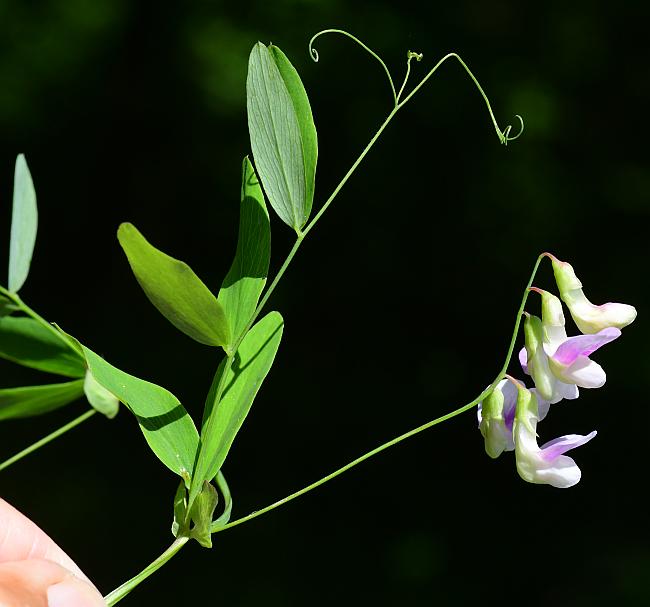Lathyrus palustris L.
Marsh Pea

Native
CC = 10
CW = -5
MOC = 16
© SRTurner
Lathyrus palustris L.Marsh Pea | |
 |
Native CC = 10 CW = -5 MOC = 16 |
© SRTurner |
|
Family - Fabaceae/Faboideae Habit - Rhizomatous perennial forb, not producing tubers. Stems - Trailing or climbing, to 1 m, unbranched or few-branched from the base, glabrous, angled or narrowly winged, the wings to 1 mm wide.
Leaves - Alternate, even-pinnately compound, mostly with 6 leaflets, some of them occasionally with 4, 5, or 8 leaflets. Petioles 0.8-3.0 cm long, unwinged, the tendrils branched or some of them unbranched. Stipules 6-18 mm long, 4-10 mm wide, ovate to broadly ovate, the basal lobe 4-8 mm long, triangular to rounded-oblong and sometimes toothed. Leaflets 2-8 cm long, 3-20 mm wide, elliptic to narrowly elliptic, narrowly lanceolate, or linear, angled at the base, angled to a bluntly or sharply pointed tip, the midvein sometimes extended into a minute sharp point at the very tip, glabrous.
Inflorescences - Open racemes of 2-6 flowers, the stalk 3-6 cm long, the individual flower stalks 2-6 mm long.
Flowers - Calyces with the tube 3-4 mm long, glabrous or hairy, the lobes 1-6 mm long, the upper 2 short and triangular, the lowermost lobe 2-3 times as long as the upper 2, narrowly lanceolate-triangular, the lateral lobes of the lower lip intermediate in size and shape. Corollas 12-20 mm long, reddish purple, to purple, lavender, or pink (rarely white elsewhere). Filaments with the fused portion 9-10 mm long, the free portion 3-4 mm long. Ovary glabrous.
Fruits - Legumes 4-6 cm long, 4-5 mm wide, linear to narrowly oblong, flattened, glabrous or with sparse, minute glandular hairs, 5-10-seeded. Seeds 3.0-3.5 mm long, more or less globose to slightly angular, not or only slightly flattened, the surface smooth, reddish brown to greenish brown or nearly black, sometimes faintly mottled. Flowering - May - June. Habitat - Fens, acid seeps, bottomland forests. Origin - Native to the U.S. Lookalikes - Other species of Lathyrus, especially L. venosus; also, some vetches (Vicia spp.). Other info. - This is an uncommon species in Missouri, mostly restricted to higher quality fen habitats toward the eastern side of the state. It is more common in portions of the upper Midwest and Canada, and also occurs in the Pacific Northwest. It is identified by its pinnately compound leaves which usually bear six leaflets and a terminal tendril, relatively large, broad stipules, and inflorescences of pea-pattern flowers. The flower calyces are glabrous and the number of flowers per inflorescence usually does not exceed six. Photographs taken at Grasshopper Hollow, Reynolds County, MO, 6-20-2022 (SRTurner). |